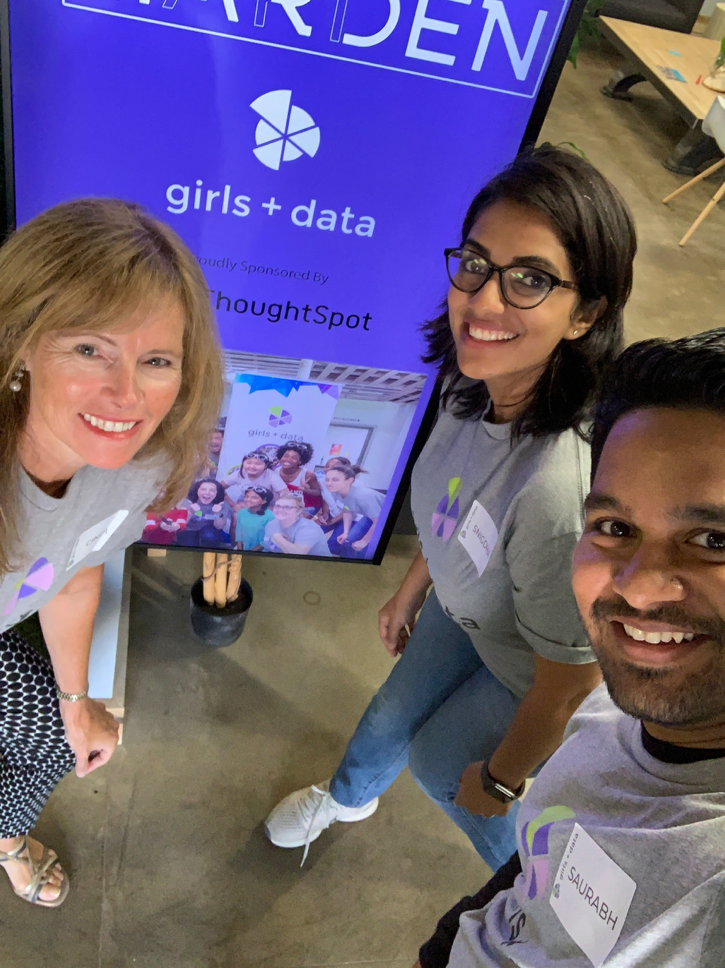I started my career in data and tech accidentally in 1988. I had always loved math, but not science so at that time, my writing abilities seemed my most likely future. Imagine: aspiring writer, but lousy typist discovers word processing on a network that kept crashing. Reading Novell network manuals and writing Lotus macros led from one thing to another. I didn’t know then that I was joining at the peak of women in tech. Where did it go wrong and why is it so friggin hard to improve diversity in tech?
Mention the word diversity and some will bristle, associating it with political correctness gone bad. Others think it’s women complaining. Some male workers feel beaten into silence, fearful of quotas that will lessen their competitiveness for the best jobs. Others see improving diversity as a moral responsibility.
But the need for diversity is much more fundamental. It all has to do with the real value diversity of thought brings to teams and their organizations.
The Business Case for Diversity
The best case for diversity remains grounded in the business benefits. Consider some of these most compelling studies:
38% more revenues from innovative products and services, according to a study from Boston Consulting Group and the University of Munich
21% more likely to have above average profitability if in top quartile for gender diversity, according to the McKinsey study.
45% more likely to capture new market if leadership has type two diversity, according to the Center for Talent and Innovation
Those are all great statistics, but let’s also put the biggest benefit of all as we increasingly move to an AI world: reduced risk of bias at scale. When teams building algorithms lack diversity, they often miss biases in the data sets used to train models and even logic in the models themselves. For a recent classic example of selection bias, you can see Forbes’ miss on listing the most innovative leaders. LinkedIn has historically suffered from some similar mistakes but with diversity improving in the engineering team, the company has been actively working to remove such unconscious gender bias. Beyond gender diversity, facial recognition programs continue to do poorly on black people, a minority of engineers in AI and in the training data sets.
How Bad Is It
The lack of diversity by gender varies country by country with only about 22% of women in tech in the USA, but Women in Big Data in Germany is worse at about 13%.
But that’s just one type of diversity. Take ethnicity. The lack of diversity by ethnicity is harder to track because most European countries do not allow the data to be captured at all. Certainly, differences in ethnicity will also vary significantly by country, but it’s clear the demographics in tech in no way mirror the overall population.
Why Women are Opting Out of Tech
The reasons for low gender diversity are multi-faceted.
Pipeline: Girls are often self selecting themselves out of tech as early as middle school. They may be “excellent” at more liberal arts courses and only “good” at math and sciences, so they opt for these focus areas (for me, excellent in English and math, but not science). However, even when they are “excellent” at STEM subjects, they opt out because they’re often a minority. There’s also social pressure to avoid being labeled a geek. Some researchers suggest that the whole decline started in the 1980s when Apple began marketing the personal computer as “toys for boys.”
Recruiting: So if there is already only a small pool of tech and data and analytics experts from which to recruit women, companies have a hard time finding those women. Job posts are written in ways that are geared toward men, discouraging women from even applying. As AI is further used to match applicants, those algorithms have also shown biases that favor male applicants.
Inclusion and unconscious bias: Even when women are brave and persistent enough to work in tech, the ongoing challenges of being overlooked, unheard, underpaid (see this excellent but disheartening TDWI analysis by Fern Halper) and a myriad of unconscious biases can make a career in tech harder than it already is. Just look at all the toxic ‘bro cultures’ running rampant in Silicon Valley and beyond. I personally have never experienced that toxicity, but I do see unconscious bias as the larger challenge. No matter my accomplishments, I continue to be perplexed when a male colleague simply “forgets” to introduce me in a room. Sure, I’m sometimes soft spoken, but I’m not invisible. It was surprising for me to hear Erica Lockheimer, VP of Engineering at LinkedIn describe a similar experience (more highlights from her talk in this blog).

Daniel Craig joined by a ‘female assistant’ AKA Barbara Broccoli, the producer of the James Bond film series
Working parents and hard choices: Working mothers may choose to have a lull in their careers, and that lull may make it especially difficult to rejoin the technology field. Technology changes rapidly and skills become outdated in a matter of months.
Tough Job: I hosted my first panel in Women in Tech at TDWI in 2013 in reaction to a USA Today article that portrayed women in tech as “having it all” (my response here). At the time, I did not at all feel like I had it all, and the women profiled in the article did not seem to have it all either. I felt like I was constantly choosing between being a good mother and doing a good job, living on the edge of a catastrophe in the making – both at home and work. When s**!@ happens in tech, it is all hands on deck – weekends, evenings, whatever. The product has to ship, the bug must be fixed by morning, the data breach needs to be plugged ASAP, the keynote must be delivered, power outage or not. Women have written to me about the difficult choices they have had to make between careers and family, or careers and any kind of life outside work at all. I called that first panel, “Having it All or Hard Choices.” When Cheryl Sandberg’s book Lean In first came out, I thought, “forget leaning.” I’m just trying to stay standing!
No Easy Fixes
Let’s be clear - there are no easy fixes. When the root causes of low diversity are multi-faceted, the solutions also need to be multi-pronged if we want to change the status quo.
Pipeline: I love the work that Girls Plus Data is doing to spark the interest in data and tech in girls in middle school. Vodafone also recently hosted a series of workshops across Europe also aimed at middle school girls. Sparking their interest earlier is a huge step, retaining it and adjusting the curriculum in high school and college is a slow work in progress. She++ and Girls Who Code are also excellent organizations. However, I’d like to see more emphasis on systems architecture and human centered design, not necessarily coding.

Recruiting: Study your job postings for buzzwords that discourage women from applying. Don’t list 15 skills requirements, but instead list only the top essential ones (women will apply only when they meet all of the requirements, while men will apply if they meet some). Recruit in less obvious schools and degrees – like the psychologist who also is a data scientist or the arts major who could improve the UX. Consider the schools and the majors. Advertise in professional affiliations geared toward women such as Women in Data, Women in Big Data, and WITI. Use LinkedIn’s optional ability to remove photos for gender-blind reviews.
Inclusion and bias: I have been pleased to see the number of organizations offering and requiring people at all levels to attend unconscious bias training. And yet, I remain mystified that some people are largely unaware of these unconscious biases and their impact. If these unconscious biases are not actively addressed, you may hire women but they won’t remain for long.
Working parents and hard choices: The degree that both parents work involve personal, professional and financial reasons, and it saddens me that we still have these mommy and daddy wars going on. At the Gartner BI Bake Off this year, we found that stay at home dads are some of the loneliest people. Juggling children’s sports schedules, school pickups, and child care, while also being a high performing tech worker pushes the boundaries of stress. For any working mother who decides to slow down or opt-out of work for a period of time, if you want to return to tech, then you MUST keep your skills up to date. Read, take an online course, periodically attend a conference. But realistically, you cannot go into radio silence and then expect to come back without investing in any required skills.
That said, employers can do more to help facilitate these transitions by allowing part time work, flex time, and job sharing. Work life balance is not just about parents and children. It is also about people caring for elderly parents, being active in your community, and just wanting to have a personal life outside of work. I started my MBA when my daughter was a year old. My son was born near the end of my first year (surprise!). As I had no idea how to handle any of this, one of my school research projects in 1998 was on the relationship between those students who had good work-life balance and those who did not. Indeed, the high performers had better balance. In other words, it’s in everyone’s best interests to figure these dynamics out or we can never improve diversity in tech.
Glimmers of Progress
Some organizations such as Accenture have set aggressive gender parity goals, aiming for a 50/50 split of men and women. The Sydney Police Force also has such aggressive plans . Personally, I think this goal is too aggressive and I worry about reverse discrimination. There are some professions that women and men naturally gravitate towards. However, the concern with fewer women in tech is that this is where the jobs are increasingly going, and where women are increasingly leaving. So I don’t know what the right mix is, but the portion of women should certainly be higher and trending upward from where we are today. A number of tech firms now externally report their diversity statistics, and there are signs of progress. I am inspired and thrilled to see new groups such as Women in Data and Women in Big Data provide networking, mentoring, training and expertise to women in this space. These are forums and events where women are not the minority for a change and ones in which men are invited to participate.
I may not have aspirations to land on the moon. I do, however, hope that the tech industry gets to the point where we have a diverse workforce without everyone having to work so hard to overcome the obstacles and unconscious biases. Improving diversity should not be a moon shot.








